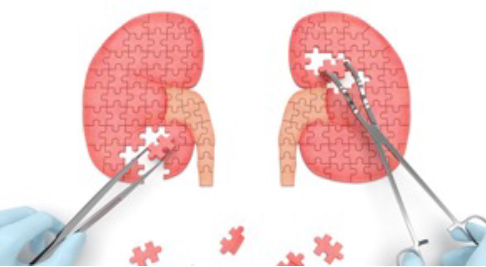A kidney transplant is a surgery to place a healthy kidney from a living or deceased donor into a person whose kidneys no longer function properly.
The kidneys are two bean-shaped organs located on each side of the spine just below the rib cage. Each is about the size of a fist. Their main function is to filter and remove waste, minerals and fluid from the blood by producing urine.
When kidneys lose this filtering ability, harmful levels of fluid and waste accumulate in the body, which can raise blood pressure and result in kidney failure (end-stage renal disease). End-stage renal disease occurs when the kidneys have lost about 90% of their ability to function normally. End-stage renal disease occurs when the kidneys have lost about 90% of their ability to function normally.
Common causes of end-stage kidney disease include:
- Diabetes
- Chronic, uncontrolled high blood pressure
- Chronic glomerulonephritis — an inflammation and eventual scarring of the tiny filters within the kidneys
- Polycystic kidney disease

Which Organs & Tissues Can Be Transplanted?
Organs that can be transplanted are:
- Heart
- Kidneys
- Liver
- Lungs
- Pancreas
- Intestine
- Thymus
Tissues that can be transplanted are:
- Bones
- Tendons
- Cornea
- Skin
- Heart Valves
- Nerves
- Veins
Worldwide, kidneys are the most commonly transplanted organs, followed by liver and then the heart. Corneae and musculoskeletal grafts are the most commonly transplanted tissues.
How Is Kidney Transplant Done?
Kidneys for transplantation come from two different sources
The Living Donor
Sometimes family members including brothers, sisters, parents, children (18 years or older), uncles, aunts, cousins, a spouse or a close friend may wish to donate a kidney. Such a person is called a “living donor.” The donor must be in excellent health, well-informed about transplantation and be able to give informed consent. Any healthy person can donate a kidney safely.
Deceased Donor
A deceased donor kidney comes from a person who has suffered brain death. The Uniform Gift Act allows everyone the consent to organ donation for transplantation at the time of death and allows families to provide such permission as well. After permission for donation is granted, the kidneys are removed and stored until a recipient has been selected.
Transplant Evaluation Process
Regardless of the type of kidney transplant – living donor or deceased donor – special blood tests are needed to find out what type of blood and tissue is present. These test results help to match a donor kidney to the recipient.
Blood Type Testing
The first test establishes the blood type. There are four blood types: A, B, AB, and O. Everyone fits into one of these inherited groups. The recipient and donor should have either the same blood type or compatible ones unless they are participating in a special program that allows donation across blood types. The list below shows compatible types
- If the recipient’s blood type is A, the donor’s blood type must be A or O
- If the recipient’s blood type is B, the donor’s blood type must be B or O
- If the recipient’s blood type is O, the donor’s blood type must be O
- If the recipient’s blood type is AB, the donor’s blood type can be A, B, AB, or O
The AB blood type is the easiest to match because that individual accepts all other blood types.
Blood type O is the hardest to match. Although people with blood type O can donate to all types, they can only receive kidneys from blood type O donors. For example, if a patient with blood type O received a kidney from a donor with blood type A, the body would recognize the donor kidney as foreign and destroy it.
Tissue Typing
The second test, which is a blood test for human leukocyte antigens (HLA), is called tissue typing. Antigens are markers found on many cells of the body that distinguishes each individual as unique. These markers are inherited from the parents. Both recipients and any potential donors have tissue typing performed during the evaluation process. To receive a kidney where the recipient’s markers and the donor’s markers are all the same is a ‘perfect match’ kidney. Perfect matched transplants have the best chances of working for many years. The perfect match kidney transplants come from siblings. Although, tissue typing is done despite partial or absent HLA match with some degree of ‘mismatch’ between the recipient and donor.
Transplant Surgery
The transplant surgery is performed under general anesthesia. The operation usually takes 2-4 hours. This type of operation is a heterotopic transplant, meaning the kidney is placed in a different location than the existing kidneys. (Liver and heart transplants are orthotopic transplants in which the diseased organ is removed and the transplanted organ is placed in the same location.) The kidney transplant is placed in the front (anterior) part of the lower abdomen, in the pelvis.
The original kidneys are not usually removed unless they are causing severe problems such as uncontrollable high blood pressure, frequent kidney infections or are greatly enlarged. The artery that carries blood to the kidney and the vein that carries blood away is surgically connected to the artery and vein already existing in the pelvis of the recipient. The ureter or tube that carries urine from the kidney is connected to the bladder. Recovery in the hospital is usually 3-7 days.
Complications can occur with any surgery. The following complications do not occur often but can include:
- Bleeding, infection or wound healing problems.
- Difficulty with blood circulation to the kidney or problem with flow of urine from the kidney.
These complications may require another operation to correct them.